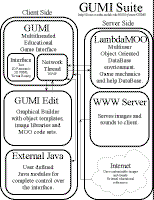How MUD Games Work
Introduction
MUD stands for Multi-User Domain/DungeonMOO stands for MUD, Object-Oriented
LambdaMOO was developed at the Xerox Palo Alto Research Center (PARC), primarily by Pavel Curtis; it is freely available from http://ftp.lambda.moo.mud.org/pub/MOO/.
The MUD-based games operate on a client-server model.
-
The player/user works on a desktop machine, either
- using a text-based client like tkMOO-light
- using a graphically based game client designed specifically for the purpose
- using client software; i.e. a Java Applet launched from a Java-enabled web browser like Netscape or Internet Explorer (IE).
-
The server is typically a Unix machine with the following
services:
- Unix networking services (daemons): FTPd, telnet, etc.,
listening for FTP or telnet requests on standard ports (usually 19 and 23)
- A web server (daemon): httpd, listening for http requests,
usually on port 80
- A MUD/MOO, listening for telnet requests, usually on port
7777 or 8888
- A MUD/MOO, listening for http requests, usually on port 7778 or 8889, respectively
- Unix networking services (daemons): FTPd, telnet, etc.,
listening for FTP or telnet requests on standard ports (usually 19 and 23)
LambdaMOO is a virtual environment composed of a server, a database, a messaging system, and an object-oriented programming language called LambdaMOO. See lambdamoo.html for more technical detail.
Connecting to a MUD-based Game
When a player connects to a game, the following occurs:

Click on this image to see a larger verion. |
|
Connecting to a MUD-based Web Server
Most of the MUDs running MUD-based games listen on two ports.Port number 7777 or 8888 is conventionally used for responding to game requests and subsequent interactions.
Port 7778 or 8889, respectively, are normally used by the MUDs to respond to HTTP requests. See, for example, the Web servers hosted by Dollar Bay, the Dollar Bay product list and Blackwood.
When a user points their browser directly at a MUD, following occurs:
- The browser sends an HTTP 'get' request to the MUD which processes the argument and resolves it to an object
- The object's description is evaluated by the MUD and passed to the MUD's HTTPD object
- The necessary HTTP syntax is prepended to the description text and returned to the browser.
- The browser interprets the return value as though it were a web page, and displays it as appropriate
See Understanding LambdaMOO Networking for more detail.
History: 28Jan2001, 21Jan2016; Contact: slator@cs.ndsu.edu